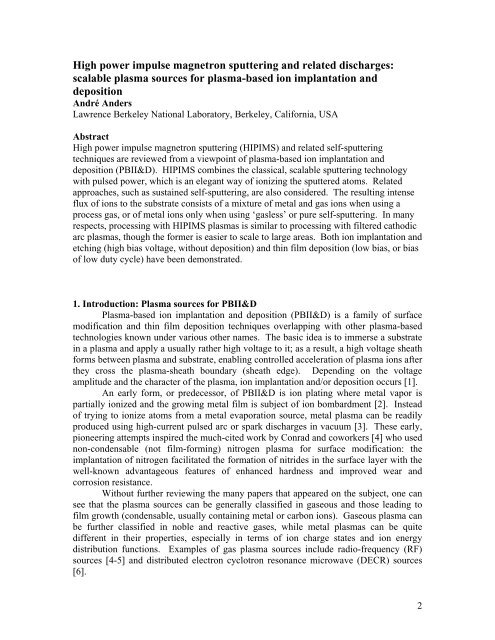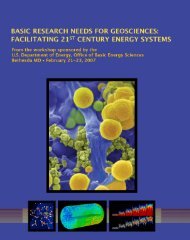High power impulse magnetron sputtering and related discharges
High power impulse magnetron sputtering and related discharges
High power impulse magnetron sputtering and related discharges
Create successful ePaper yourself
Turn your PDF publications into a flip-book with our unique Google optimized e-Paper software.
<strong>High</strong> <strong>power</strong> <strong>impulse</strong> <strong>magnetron</strong> <strong>sputtering</strong> <strong>and</strong> <strong>related</strong> <strong>discharges</strong>:<br />
scalable plasma sources for plasma-based ion implantation <strong>and</strong><br />
deposition<br />
André Anders<br />
Lawrence Berkeley National Laboratory, Berkeley, California, USA<br />
Abstract<br />
<strong>High</strong> <strong>power</strong> <strong>impulse</strong> <strong>magnetron</strong> <strong>sputtering</strong> (HIPIMS) <strong>and</strong> <strong>related</strong> self-<strong>sputtering</strong><br />
techniques are reviewed from a viewpoint of plasma-based ion implantation <strong>and</strong><br />
deposition (PBII&D). HIPIMS combines the classical, scalable <strong>sputtering</strong> technology<br />
with pulsed <strong>power</strong>, which is an elegant way of ionizing the sputtered atoms. Related<br />
approaches, such as sustained self-<strong>sputtering</strong>, are also considered. The resulting intense<br />
flux of ions to the substrate consists of a mixture of metal <strong>and</strong> gas ions when using a<br />
process gas, or of metal ions only when using ‘gasless’ or pure self-<strong>sputtering</strong>. In many<br />
respects, processing with HIPIMS plasmas is similar to processing with filtered cathodic<br />
arc plasmas, though the former is easier to scale to large areas. Both ion implantation <strong>and</strong><br />
etching (high bias voltage, without deposition) <strong>and</strong> thin film deposition (low bias, or bias<br />
of low duty cycle) have been demonstrated.<br />
1. Introduction: Plasma sources for PBII&D<br />
Plasma-based ion implantation <strong>and</strong> deposition (PBII&D) is a family of surface<br />
modification <strong>and</strong> thin film deposition techniques overlapping with other plasma-based<br />
technologies known under various other names. The basic idea is to immerse a substrate<br />
in a plasma <strong>and</strong> apply a usually rather high voltage to it; as a result, a high voltage sheath<br />
forms between plasma <strong>and</strong> substrate, enabling controlled acceleration of plasma ions after<br />
they cross the plasma-sheath boundary (sheath edge). Depending on the voltage<br />
amplitude <strong>and</strong> the character of the plasma, ion implantation <strong>and</strong>/or deposition occurs [1].<br />
An early form, or predecessor, of PBII&D is ion plating where metal vapor is<br />
partially ionized <strong>and</strong> the growing metal film is subject of ion bombardment [2]. Instead<br />
of trying to ionize atoms from a metal evaporation source, metal plasma can be readily<br />
produced using high-current pulsed arc or spark <strong>discharges</strong> in vacuum [3]. These early,<br />
pioneering attempts inspired the much-cited work by Conrad <strong>and</strong> coworkers [4] who used<br />
non-condensable (not film-forming) nitrogen plasma for surface modification: the<br />
implantation of nitrogen facilitated the formation of nitrides in the surface layer with the<br />
well-known advantageous features of enhanced hardness <strong>and</strong> improved wear <strong>and</strong><br />
corrosion resistance.<br />
Without further reviewing the many papers that appeared on the subject, one can<br />
see that the plasma sources can be generally classified in gaseous <strong>and</strong> those leading to<br />
film growth (condensable, usually containing metal or carbon ions). Gaseous plasma can<br />
be further classified in noble <strong>and</strong> reactive gases, while metal plasmas can be quite<br />
different in their properties, especially in terms of ion charge states <strong>and</strong> ion energy<br />
distribution functions. Examples of gas plasma sources include radio-frequency (RF)<br />
sources [4-5] <strong>and</strong> distributed electron cyclotron resonance microwave (DECR) sources<br />
[6].<br />
2

















